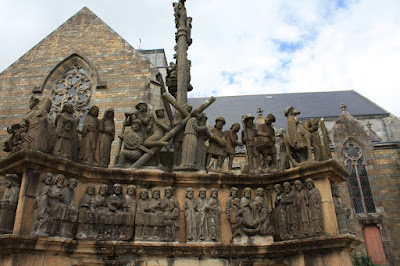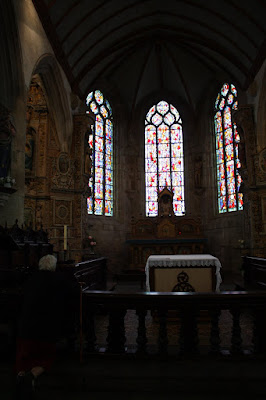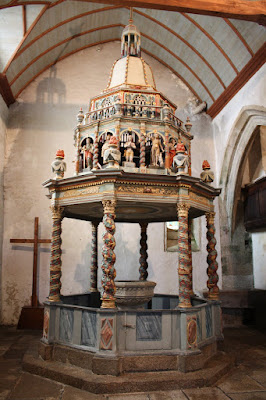 Before starting out, we stopped at the tourist office for some information , and reservations for a boat trip later in the week. While there we saw announcements of a visit from a typical Breton ship open for visiting -- right then. So we grabbed some sandwiches and a tart from the patisserie across the street and headed for the ship.
Before starting out, we stopped at the tourist office for some information , and reservations for a boat trip later in the week. While there we saw announcements of a visit from a typical Breton ship open for visiting -- right then. So we grabbed some sandwiches and a tart from the patisserie across the street and headed for the ship.We had actually seen it on our way into town -- Tom keeps track of the comings and goings of the various vessels ties up along the river. Typically French, she was beautifully restored and outfitted with posters explaining her history. Her three crew members were on hand to show off various aspects of the ship. They even included wine, cider, dried sausage and potato chips!

 We stopped in a little village a few minutes away across the street from the church to eat our lunch. it featured a small tart topped with famous local strawberries -- more about them later!
We stopped in a little village a few minutes away across the street from the church to eat our lunch. it featured a small tart topped with famous local strawberries -- more about them later!
 Our first parish close of the day was in Daoulas, a small, picturesque village a few minutes north. The church, cemetery and a chapel were open for visitors. Apparently there was another chapel in an abbey adjacent to the church, and another up the hill 100 meters, but we decided we had too much to see to try to see everything here. But four churches within sight of one another? In a small village?
Our first parish close of the day was in Daoulas, a small, picturesque village a few minutes north. The church, cemetery and a chapel were open for visitors. Apparently there was another chapel in an abbey adjacent to the church, and another up the hill 100 meters, but we decided we had too much to see to try to see everything here. But four churches within sight of one another? In a small village?

 The chapel across the street
The chapel across the street

Our next stop was in Plougastel-Daoulas. The calvaire there is one of the most ornate in Brittany, and looked very old. It was built in about 1598 after an outbreak of plague. It had been heavily damaged in WWII, with artillery fire and in ground combat. One of the American soldiers involved in the fighting came back soon after the war, having raised money in the US, and helped in the rebuilding of the calvaire. He was made an honorary citizen of the city.




Inside the church were carved, unpainted wood side altar pieces and decorations, a contrast to the colored beams across the ceiling, and the modern alter in the center of the church.

 The village war memorial in the parish grounds
The village war memorial in the parish grounds
We then sped away about an hour to St.-Thegonnec, impressive for its calvaire and its pulpit of almost 200 figures. While the guidebooks say the calvaire dates from 1581-8, the figures seemed much more modern. They follow the life of Christ from birth to resurrection, quite a feat in such a small structure. The calvaire had steps going inside, and although it is not clear how, apparently the priest is able to climb to the top and give sermons, using the figures as visual aids.
This is the downhill view of the church, which includes and entrance through the wall with steps up to the close level; the entrance is a war memorial, listing names on both sides of those from the village lost in WWI.


The uphill side of the church featuring the calvaire.




Inside the church




The church was heavily damaged by fire in 1998, so I think this baptistry is new, and so much less ornate than the older ones.
 A new organ.
A new organ. They did manage to save the pulpit in the fire, with the magnificent, painted carvings.
They did manage to save the pulpit in the fire, with the magnificent, painted carvings.



Tom thinks there must be a lot of sinning in St.-Thegonnec, since there were five of these lovely confessionals for the very tiny village.

This is a "simple" statue near the side entrance to the church.

Our next village was Guimiliau, a village of linen producers. The close of this tiny village was impressive even from some distance away.


 The clavaire is the structure with the cross at the top. It also featured figures from the life of Christ, and also allowed the priest to climb inside and preach from the top platform.
The clavaire is the structure with the cross at the top. It also featured figures from the life of Christ, and also allowed the priest to climb inside and preach from the top platform.
The birth of Christ
 The Adoration
The Adoration Palm Sunday
Palm Sunday The Last Supper
The Last Supper
I was delighted to see a young woman at the door of the church giving information, wearing the coiffe of the region. I suspect this was just part of her official dress for the day, but none of the guides at the other churches were wearing them. It looked like a handy thing to pop on for a bad hair day.


She was pointing out the carvings on the "porch" of the church, which also depict or symbolize various bible stories, and were also used to teach the congregation.

 It seemed as though we were far from the only folks bagging parish closes that day. we saw many of the same people arriving and leaving as we did, with the same cameras. Some were Italian, but most were French. Who knew parish closes could be such a draw?
It seemed as though we were far from the only folks bagging parish closes that day. we saw many of the same people arriving and leaving as we did, with the same cameras. Some were Italian, but most were French. Who knew parish closes could be such a draw?Inside the church we were treated to an organ practice. The music was not terribly inspiring, but it was nice to know it really worked. There was also an elaborate baptistry, this one carved, unpainted wood, and even more elaborate carved, painted altar decorations. The pulpit in this church was also elaborately carved wood.







The last parish close on our list was Lampaul-Guimiliau, about 5 minutes from Guimiliau. As we crossed the few fields from one village to another, each with a magnificent church, I had to wonder why they went to so much trouble. An informational plaque at the church explained why -- although a much smaller village that Guimiliau, Lampaul-Guimiliau was a tannery town, with many wealthy residents. It simply would not do to have a less ostentatious church. They note that while their calvaire is smaller, they are a smaller village, and their church is prettier. The calvaire is a relatively small structure with a single set of figures near the crucifix.


 St. Michael and his demon.
St. Michael and his demon.
 The main alter was flanked by two alters in this style. The center panel depicts stories from the passion, featuring the three crucifixes at the top of the panel.
The main alter was flanked by two alters in this style. The center panel depicts stories from the passion, featuring the three crucifixes at the top of the panel.

e
 The baptristry
The baptristry Another organ, in the same elevated style.
Another organ, in the same elevated style.

Our very last stop was the village of Le Faou, juts a few minutes from home. We had bought a set of hand-sewn and embroidered square pillowcases at an antique shop the first morning in the area; we returned to see (and of course, buy) lovely linen pillowcases in long rectangles. In the parking lot was a typical Breton character (with a typical breton hanger-on who had already started cocktail hour), selling the famous Plougastel-Daoulas strawberries from our lunchtime tart. So we brought a box home for dessert. They are very light in texture and flavor, making the typical California strawberry a much more muscular experience. The flavor is a more pure strawberry flavor, at the same time thin and light. Every one was at the peak of ripeness and perfect.


A strawberry postscript: We ate half the berries last night after dinner, and planned to have the other half this evening. About half of the berries had simply disintegrated -- they looked perfect, but when touched, they collapsed into mush. So when the man said "These are for tomorrow", he meant it!
No comments:
Post a Comment